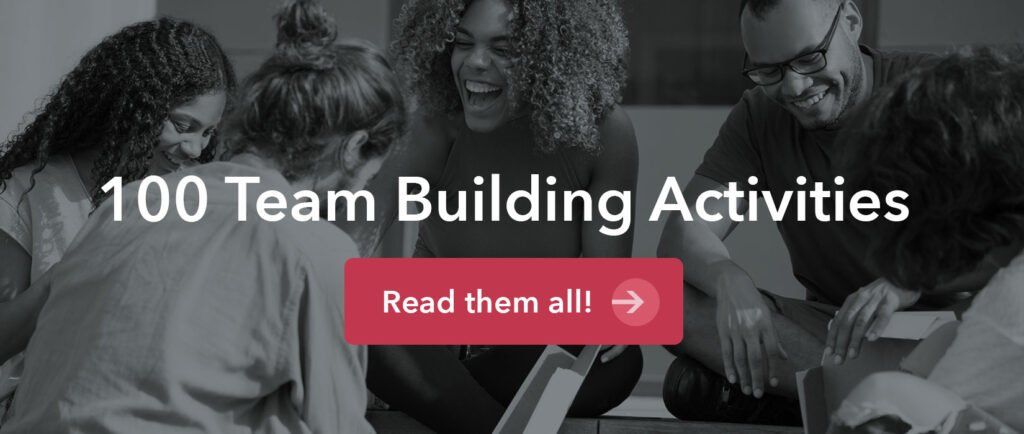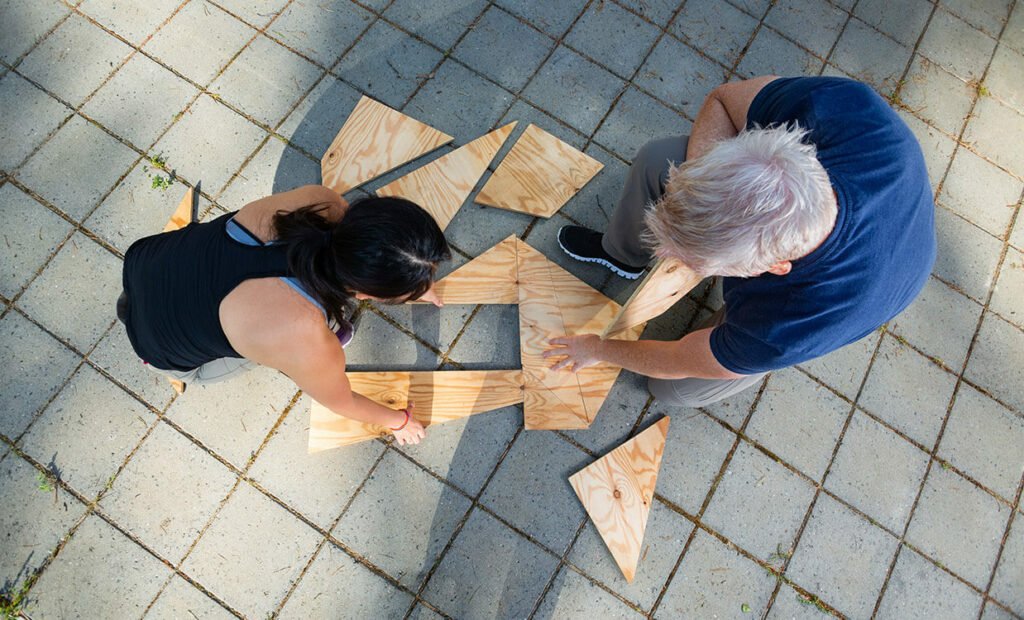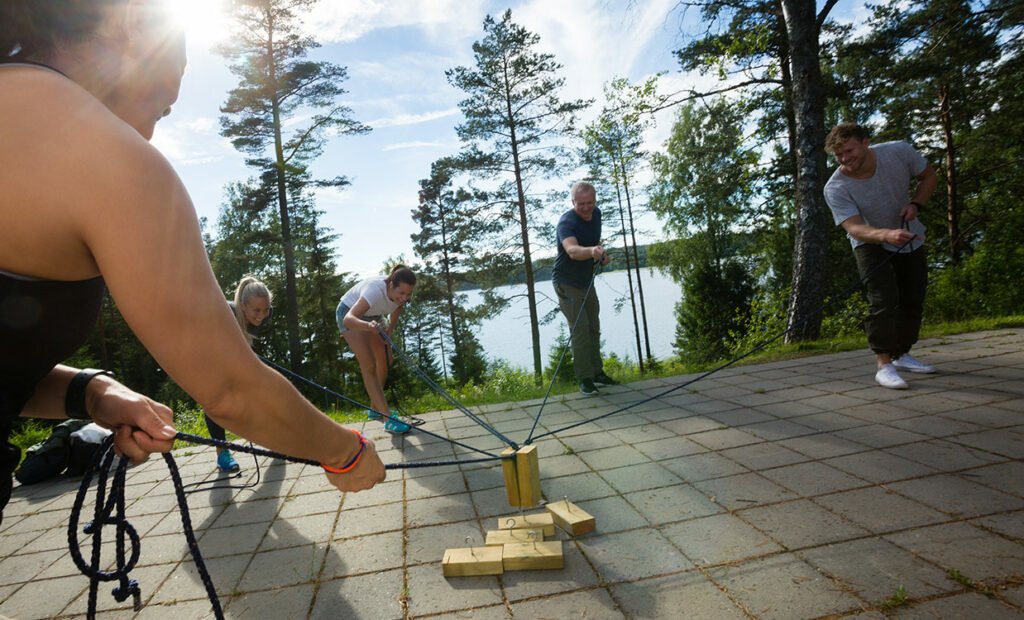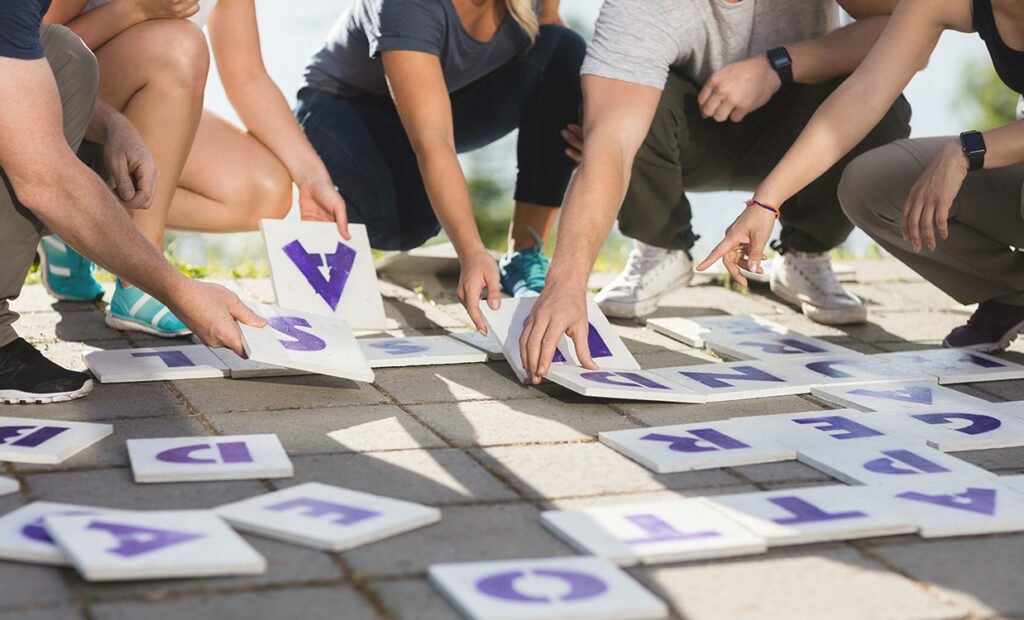
Article
5 min read
Team building: The complete guide
Nikki Thorpe
Oct 22, 2019
Chapters
Team Building: The Complete Guide
When you hear the words team building strung together in a sentence, what comes to mind?
Maybe you’re inwardly cringing at repressed memories of those intrusive and awkward ice-breaker questions your manager insisted on asking every new team member in their first meeting.
Or, perhaps you have residual PTSD from that time you were made to try out a “trust fall” with a new employee, only to fail to catch the person on time? (Ouch!)
If you’ve been in the working world for more than a few years, you’ll in all likelihood have suffered through more than your fair share of team-building exercises that either fell flat, were borderline inappropriate or just excruciatingly dull.
While most of us have a pretty good idea of how team building is done in the traditional sense, it’s a little harder to nail down exactly what it’s actually meant to achieve – and how managers or business owners can do it well.
That’s what we’ll cover in this guide.
- What is team building?
- Why is team building important?
- What are the different approaches to team building?
- What are the different stages of team development?
- What team building activities can I use?
What is team building?
Team building is an ongoing process that refers to the tactics and actions you or your business takes to turn a group of individuals into a cohesive team.
Whether you have a working team or are bringing together a disparate group of employees to work together on a one-off project, like an event, team building comes into play in a variety of ways.
When thinking about team building, it’s important to get a sense of the different relationships that form within teams:
- The relationship that develops between team members.
- The relationship that develops between individuals on the team and the team as an entity on its own.
In practice, team building can look like many different things.
Examples of team building:
- Formalised team building sessions, with set tasks/goals that participants have to work together on to complete
- Annual or quarterly team games, events and offsites
- Personality tests designed to help team members learn more about one anotherExamples of passive team building:
- Shared team culture and vision
- Team rituals (daily stand ups, project kickoffs, one-on-one meetings, etc.)
- Peer-to-peer coaching
- Collaboration/project management tools that help team members stay connected and organised as they work (i.e. Slack, Planday)
Why team building is important
Running a successful business requires the ability to juggle a lot of things at once. From major initiatives, like hitting business goals to prioritising and assigning work tasks, there’s a lot that goes into running the show.
With all of this, plus budget constraints to consider, it’s not surprising that, more often than not, team morale drops down the priority list. After all, as a business owner or team leader, you need to be hyper-focused on figuring out the best way to meet your business objectives.
While that’s great for the overall business, a business is only as good as its people.
Here’s the good news, though. By making team building an integral part of your company culture, you won’t have to install a full-blown arcade room or hire a massage therapist to boost employee morale and productivity (although those can certainly help!)
The benefits of team building
Before we dive into the purposes of team building, it’s worth covering two salient points:
No two employees are made alike.
Teams invariably bring together a diverse array of people who are all unique, each with their own goals, opinions, values, past work experiences, upbringings and team experiences.
Each person has different strengths and weaknesses that make them a valued member of your team. Similarly, people don’t work together in the same way. For instance, one person on your team may be all for open, honest communication and a frank exchange of ideas, while a different teammate will naturally shy away from resolving a brewing conflict.
No two teams are made alike.
Some teams just sort of plod along, working together. The best teams, though do a lot more than that. They have more fun, they get more done and they accomplish things that no one else in their industry does.
More often than not, a highly-effective team shares three common traits:
- Transparency
- Trust
- A willingness from everyone to get things done.
These key traits don’t happen by happy accident. But there are many tangible things you can do to foster them, chief of which is our topic at hand: team building.
Here are just some of the benefits of team building:
1. Team building boosts morale.
Research has shown time and time again that a sense of team togetherness yields significant benefits. Consider these statistics:
- Planday's recent survey found that 85% of hospitality workers have experienced mental wellbeing issues in the past 12 months, and;
- 51% planned to leave their current job in the near future
- Highly engaged teams are 21% more profitable
Adding to this, a Slack survey on workplace collaboration found that while employees’ priorities align with their company’s top values (”making money” and “efficiency”), there is still a considerable disconnect between company values and the values held by their employees.
For example, while workers feel that their companies most value “doing something new and innovative”, they feel that values like “being part of a team or community” and “showing a desire to work well with colleagues” should take precedence.
2. Team building helps new hires or newly-created teams to get to know each other better.
Team building can help:
- Newly-formed teams bond better more quickly
- Existing teams get back on track after a difficult period
- Integrate new team members into a new team
You want to you know each person can work well with their teammates – that’s a given. But your team will only get to that stage if relationships are allowed to grow and strengthen organically. First, team members must know one another well enough to be confident in each other’s ability to do good work, while taking ownership of their own contribution to the team’s efforts as well.
While it can seem like any attempts to build a better rapport between team members are doomed to fail (after all, cliques tend to naturally form in all workplaces), that’s really not the case. In fact…
3. Team building fosters a feeling of safety that allows great ideas to emerge.
A few years back, Google did research on what makes for an effective team within their organisation. Over the course of hundreds of interviews with employees to uncover what sets high-performing teams apart, the number one factor they identified was psychological safety.
Let’s dive into what that means:
A Harvard Business School researcher defines psychological safety as “perceptions of the consequences of taking interpersonal risks in a particular context such as a workplace.”
Here are some examples of behaviour in the workplace that exhibit psychological safety in action.
- Team members feel comfortable asking questions in team meetings about things they don’t understand.
- Team members feel secure in sharing opposing viewpoints or raising issues or concerns about how work is being done.
- Team members don’t go into blame or self-preservation mode when oversights or mistakes happen at work.
- Team members feel empowered to ask each other to help when needed.
One key way to build trust, so that everyone on your team feels secure enough to participate fully in the team?
You guessed it – by making team building a strategic priority!
4. Team building helps team members figure out how they can leverage each other’s strengths.
Instead of imposing solutions from above, you want your team to brainstorm and come up with their own ways of overcoming obstacles. When done effectively, team building encourages team members to problem solve and become greater than the sum of their parts.
By giving your team space to find the right solution and propose their ideas, you can empower them to think creatively, develop their confidence and foster a sense of collective ownership in the overall success of the team.
The four approaches to team building
There are many ways to conceptualise team building, but one of the most well known approaches is put forward by Eduaro Salas in the Handbook of Human Factors and Ergonomics:
- Goal setting
- Role clarification
- Problem solving
- Interpersonal relationships
Let’s expand on these a little more:
1. Getting the team aligned around shared goals
As a manager, it’s vital to set useful, productive goals for your team. These goals should motivate your team, be applicable to individual roles and align closely with your “big-picture” business objectives.
It’s also important that the goals you set for the team strike a balance between challenging and attainable. Following the SMART goal framework (a SMART goal stands for “specific”, “measurable”, “attainable”, “relevant” and “timely”) is a good way to get everyone working effectively as a team.
2. Building positive relationships among team members
One of the essential ingredients to being a good people manager is the ability to build relationships within your team that are based on mutual trust, support and open communication – three of the most important components of successful teamwork.
Both passive and active team building can improve interpersonal relationships on your team.
Of course, some level of interpersonal conflict isn’t always a bad thing and, in any case, it can never be avoided entirely. However, conflict between members can become a destructive force if a positive resolution is not reached.
3. Clarifying team members’ roles
One of the biggest morale and productivity killers on a team is a lack of clarity and consensus on the different team members’ roles and responsibilities. The following is a good exercise to help everyone understand each other’s contribution to the team:
Step 1. Ask each team member to write down their own responsibilities, in order of descending priority.
Step 3. Ask team members to write down what they think are the top 3 responsibilities of each person on the team.
Step 4. Make a note of any core responsibilities that aren’t covered by a member of the team.
Step 5. Have everyone on the team compare notes to determine whether there are disparities between how they perceive one anothers’ responsibilities.
Step 6. Conclude the task by creating a RACI chart to define each role, show each team member exactly what it is that they do and give individual contributors a clear sense of purpose.
4. Fostering team-based problem solving
The goal here is to promote a culture of collaborative problem-solving within the team. Rather than seeing problems as roadblocks, you want your team to see them as opportunities.
One way to help the team gain experience collaborating together would be to set smaller-scale initiatives and have the team come together to consider and come to a consensus on how to solve the issue.
Be sure to celebrate any accomplishments that arise from these initiatives. Recognition is key to reinforcing the value of the team coming together to resolve problems and strengthen their collective decision-making techniques.
What are the different stages of team development?
Bruce Tuckman, an educational psychologist, identified a four-stage process that teams must move through in order to become successful.
1. Forming
This initial stage is where the group first start working together and getting to know their new colleagues. In the formation stage, people are usually conflict-averse and prefer to work independently. They also tend to look for leadership and authority to facilitate introductions during this period of uncertainty.
2. Storming
The storming stage is usually considered the most disruptive stage of team building. It begins when a disconnect forms as a result of different working styles, ideas and perspectives. At this stage, certain team members will likely have different perspectives on how to approach the issues the team encounters.
Other team members might compete for a position of power and prioritise individual recognition over team morale. This is also the point where many team members can feel demotivated or stressed and choose to withdraw from tasks.
3. Norming
Once teams start moving into the norming stage, they have a deeper sense of the purpose and strategy behind their shared goals. They leave internal competition behind, begin to develop a set of shared values and start to resolve their differences, facilitating deeper collaboration across the group.
This is usually the stage where individual team members start feeling comfortable asking one another for help and soliciting constructive feedback on project outcomes.
4. Performing
After successfully moving through the norming stage, the team then enters the performing stage. This is where your team members are fully comfortable working together on interdependent projects. In the performing stage, team morale, cohesion, trust and productivity tends to be at its highest.
While these stages usually move in sequence, they can occasionally overlap or go backwards. An example of this would be when a new team member joins or a new project kicks off. The team might briefly revert back from a more advanced stage to either the forming and storming stages as they gear up to to start something new and or get to know the new team members.
What are some good active team building exercises to start with?
In today’s competitive world, a business can succeed or fail by its ability to facilitate effective teamwork. You’ve put a lot of work into hiring the right people. The next step is to create an environment of mutual respect and trust among team members.
This is no small task (which is why you’ve read this far!) So, whether you’re a worker responsible for facilitating up with team-building activities, or you’re a team leader, supervisor or manager looking for ways to add some fun for your teams, below are some ideas to help get your creative juices flowing.
Daily team building activities in the workplace
These team-building activities can be conducted at little-to-no cost, without any major disruption to the work day. Try one (or a few!) of these to create a stronger, more engaged team:
Two truths and a lie.
This fun icebreaker game can be completed in as little as 15 minutes and is a creative way for teams who haven’t worked together to get to know their coworkers a little better.
The idea here is that everyone briefly introduces themselves and share three things about themselves, one of which is a lie. The group must break off for a period of conversation where they can quiz each other and guess which one of the three is a lie.
The egg-drop challenge.
A classic problem-solving game for teams, the egg drop is a great way to get the group to come together over a common goal and communicate with one another.
Provide the group with a variety of tools and construction materials. Give them a half an hour to build an egg package that can protect their egg from an 8-foot drop. Drop each egg package off a ledge and see if they were able to protect their egg from breaking!
Legoman.
This is another lightning-quick activity that aims to help with team communication. All you need are some legos. Divide your team into smaller groups of two or more. Next, build a structure of your own choosing using Lego blocks within a 10-minute timeframe. After this, each team must reproduce the same structure exactly, down to colour and block sizes, within 15 minute. The catch? Only one team member is allowed to look at the original Lego structure!
Human knot.
This is another tried-and-true way to encourage team members to work together in close proximity – no equipment required! Have the group stand in a tight circle. Each person then reaches out to clasp hands with another player who aren’t directly next to them, with each hand connecting to a different person. After everyone is tangled together, the players must attempt to undo the “human knot” and form a perfect circle – without letting go of each other’s hands.
Team building outings
From cooking to art classes, there are lots of fun ways to do team building and problem solving outside of the office! Here are some more ideas that can help your employees get to know each other better:
Company retreat. Organising and executing a company retreat is no easy ask. Of course, company offsites can be cost-prohibitive when travel and accommodation costs come into play. However, it’s an especially great option for teams that don’t work closely together daily. If you choose to plan a company retreat, be sure to build structured team-building games as well as free time to allow team members to socialise with each other on an informal level.
Employee volunteering. Why not take a few hours out of the workday to participate in a Christmas giving charity program? Finding ways to give back to the community is a great help everyone gain a sense of achievement and togetherness as a group.
Escape room. A fun take on traditional team building (no trust falls here!). Escape rooms are an especially great problem-solving and collaboration exercise for teams of all sizes.
In an escape room, the team works together to find clues, solve puzzles and “escape” a locked room, usually within an hour. Escape rooms are far and away our favourite way to get more reserved team members participating and sharing their unique perspectives to help the whole team conquer a challenging task.
Scavenger hunt. Scavenger hunts are a great way to encourage deeper team bonds and some healthy competition. The best part is that it can be done at little cost – all you have to do is split the team up into smaller groups and make a list of things to find outside of the workplace. Each team must then locate and photograph everything on the list within a set time frame. The first team to tick everything off the list wins the day!
Team assessments
Team assessments. Team assessment frameworks, such as the Five Behaviors model, are designed to help employees objectively gauge their level of cohesiveness and communication as a team.
- Personality tests for team building. Personality tests are also a useful way to help the group learn more about each other’s communication styles and aspects of their personalities that can clash or help them gel with another person on the team.
One of the oldest personality tests is the Myers-Briggs test, which divides people into 16 different personality types, with the aim of giving them insights into each other’s differing strengths and weaknesses and perceptions of the world around them. Another popular workplace personality tests is the DisC Assessment.
Note: The above merely scratches the surface of what you can do in terms of active team building. For even more ideas, check out our team building activity generator! We’ve separated over 100 different team activities into different categories so you can find the right ones that fit your space, team size, budget and available time.
Inspirational quotes you can use for team building
The most successful businesses are made by great teams. Even if you hire the best candidates out there, your team won’t succeed without everyone working well together. Get your team inspired and motivated with the help of the best quotes about teamwork:
- “There is no “I” in teamwork” – Anonymous
- No one can whistle a symphony. It takes a whole orchestra to play it.” – HE Luccock
- “Nobody is perfect but a team can be.” – Meredith Belbin
- “If you want to go fast, go alone. If you want to go far, go together” – African Proverb
- “Teamwork begins by building trust. And the only way to do that is to overcome our need for invulnerability.” – Patrick Lencioni
- “Coming together is a beginning. Keeping together is progress. Working together is success” – Henry Ford
- “A group becomes a team when each member is sure enough of himself and his contribution to praise the skills of others.” – Norman Shidle
- “Great things in business are never done by one person; they’re done by a team of people.” – Steve Jobs
Want to promote better teamwork in your business?
Then team building activities are a must.
This holds true regardless of whether you have 3 employees or 30 employees, whether your employees work in a highly collaborative environment, or one where everyone works on their own projects. So start thinking of team building as a continuous process, instead of a few silly games or something to check off your to-do list once a year.
It may seem overwhelming to start with, but the simple tips and tactics outlined above can help get everyone on your team working together more efficiently. Happy team building!
Shift-based teams love Planday’s scheduling software. See how we can help your teams work seamlessly, without scheduling conflicts.

Active vs Passive Team Building - And Why You Need Both
We cover a lot of the must-know topics around team building, including the one we want to focus on right now: active team building vs. passive team building
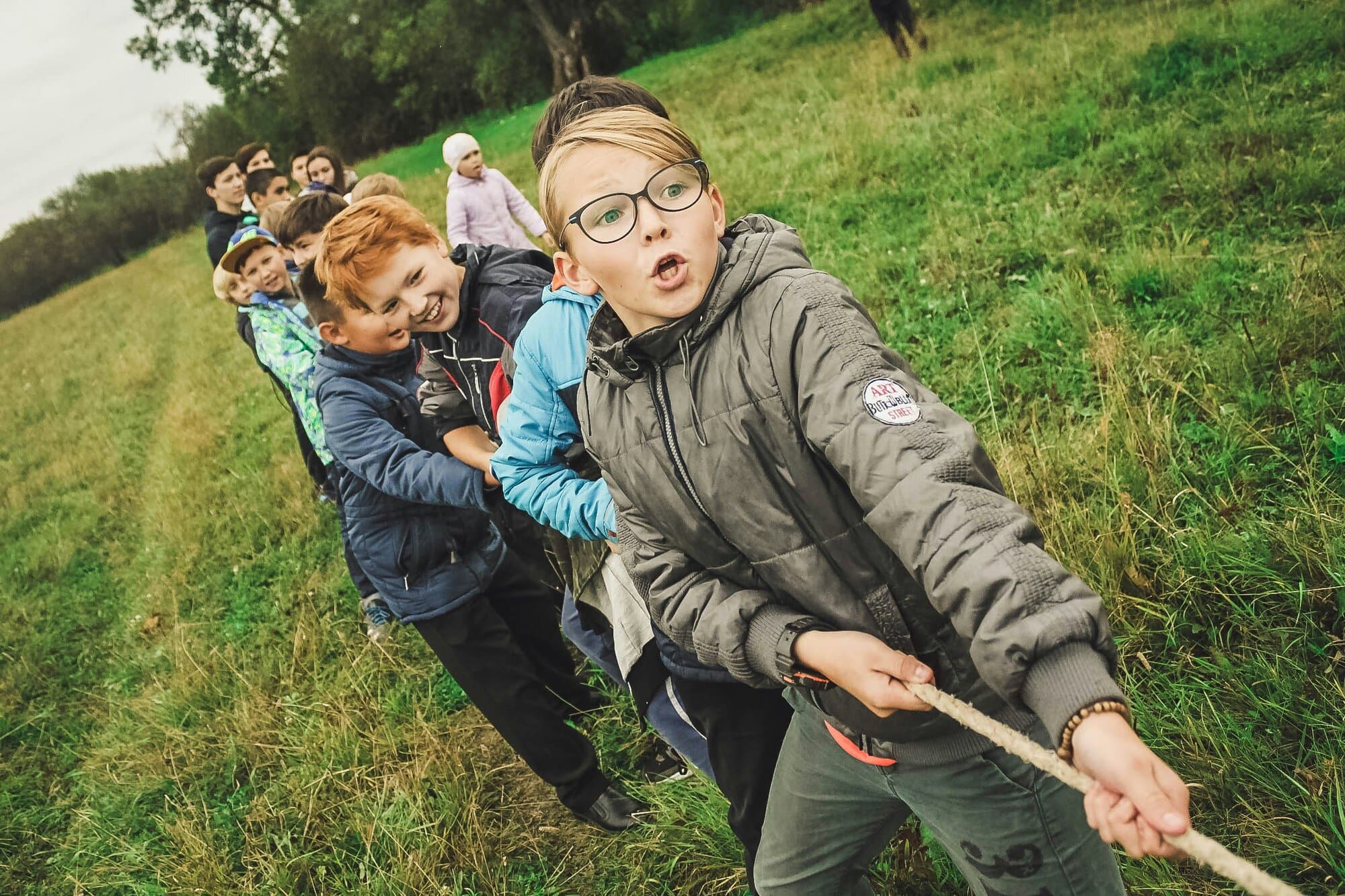
Team dynamics: How to solve the 4 most common team conflicts
Effective managers must possess several key leadership skills. One of the most crucial is the ability to manage team conflicts

Why Giving Your Team Feedback is so Important
With some advance preparation and training, you can create a dynamic team that successfully gives and receives feedback

